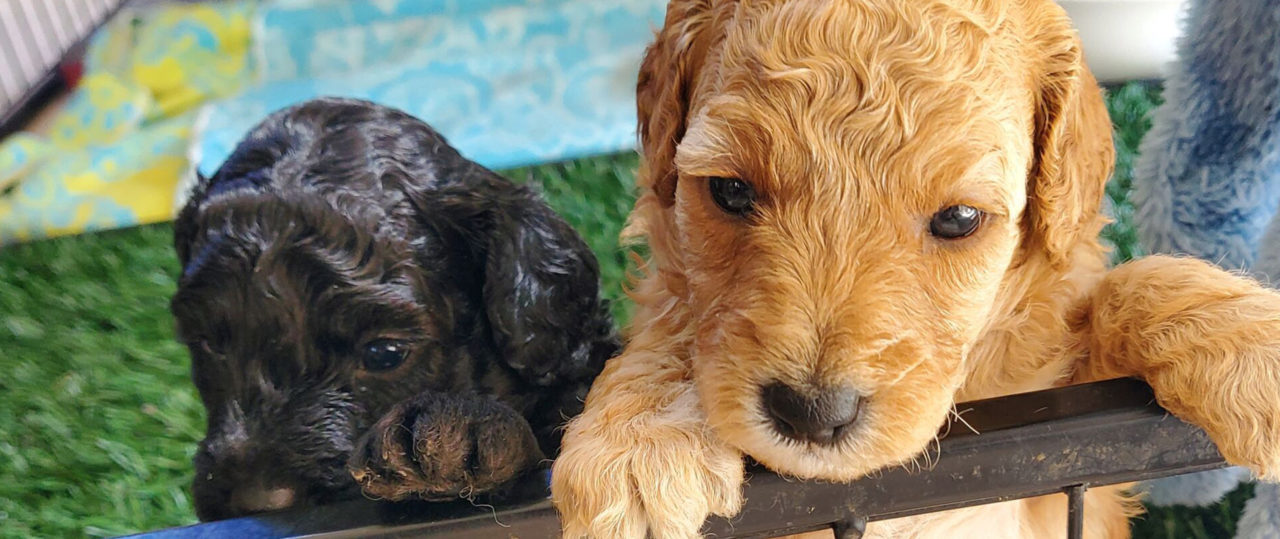Poodle, Labradoodle, Cavoodle, Spoodle & more…
Of the many coat types we get asked for advice about, the ‘poodle or doodle coats are one of the most frequent. Whether you have a Labradoodle, Spoodle, Cavoodle, Retrodoodle, or another lovely ‘poodle cross… this guide is for you. This guide covers coat types, clippers, and trimmers rated for each coat type, helps to choose blades and comb attachments, coat lengths, coat prep, and the link to a gallery full of ‘poodle clips for ideas and inspiration.
What are the different Poodle coat types?
To make sure you get the right clippers, you first need to know what coat type your ‘poodle has. The most common coats are these 3 types below:
FLEECE: Loose, shaggy waves. Soft texture. Low to non-shed. Medium to high maintenance as can be prone to knotting, especially in areas that rub, like the collar area and around the ears. Single coat (usually). Can sometimes have a cotton-soft, dense, knot-prone undercoat. Frequent brushing required if kept long.
WOOL: Often like lambswool. Similar to a Poodle coat. Normally tighter more spiral type curls compared to the fleece coat. Non-shedding. Tends to vary in texture, from lambswool texture to a dense, fine, cotton-wool texture. Typically coarser than the fleece coat. Can be high maintenance as very prone to knotting. Frequent brushing required if kept long.
HAIR or STRAIGHT: A hair coat is often wispy or wiry, typically with a mixed texture and often with mixed lengths. It’s easy maintenance and usually low to medium-shed. A straight coat is similar to the Golden Retriever or Spaniel coat type. Usually easy maintenance, typically with a silky texture, often with different lengths on different parts of the body. The straight coat is usually medium to high shed.
The myth of ‘non-shed’ coats
All coats shed, even ‘non-shed’ fleece and wool coats still shed. The difference is any old, dead coat is not ‘dropped’ or shed out like a shedding coat does, and the rate of shedding is often far lower, as the coat growth cycle tends to be slower.
Instead of dropping to the ground like a hair or straight coat does, in fleece and wool coats, a dead coat usually gets stuck in the coat. A key reason non-shed coats are much more likely to form knots and mats unless that dead coat is removed with regular brushing. That’s also why non-shed fleece or wool coats are considered high-maintenance compared to a hair or straight coat that sheds.
Beware the Poodle puppy coat change!
An ‘poodle pup goes through a coat change anywhere from 6 to 14 months of age, with 9 to 12 months being most common. That super soft, thinner, fluffy, easy-care puppy coat will transition into the adult coat, becoming high maintenance (at least in the short term). During the change, the puppy coat is being replaced by the thicker adult coat, and coat texture and color may change too. It may become less or more curly, the coat color may darken or lighten, and the rate of shedding may change. If you want to keep the coat long as an adult, you’ll need to keep it free of knots. If you can’t keep on top of the knots, you may have to clip the coat short instead.
During this change, the coat may become extremely prone to knots and mats, and daily brushing is highly recommended, moving to weekly longer-term. If not kept on top of, a pup’s first visit to the groomer may result in the coat having to be cut very short to remove the mats.
Ideally, before the coat change, you’ll already have your pup used to daily or weekly brushing. When the coat starts to change, begin daily brushing and use a pin brush or slicker brush to help remove that stuck puppy coat and prevent knots forming. A bristle brush is popular for puppy coats, but won’t remove knots and get down deep enough through the adult coat.
How to keep the Poodle coat long and free of knots
Tangles turn into knots, and knots turn into mats. Mats can cause serious health concerns from discomfort to nasty skin infections. Make sure to brush right down to the skin (which is why a pin brush, not a bristle brush, is recommended). Brush section by section, also called line brushing, to make sure you don’t miss any knots. YouTube is a good resource to see how line brushing is done.
When you discover a tangle or knot, swap to a slicker brush or grooming comb. A comb is ideal for getting out finer tangles. A slicker brush is better for knot removal. Gently ‘pat’ the knot out, starting from the end and working down to the skin. Use along with a detangler spray to reduce discomfort and help the knot separate. Spend extra time on areas that rub, including behind and under the ears, paws, armpits, ankles, backs of the legs, and around the neck.
Want fewer knots? Avoid the shampoo mistake!
Never skip conditioner with the fleece and wool coats (whether it’s a rinse-off conditioner, a spray-on, or a leave-in formula). For a shampoo to work, it needs to ‘open’ the cuticle, removing some of the protective layers of oils, in order to clean the coat. This can leave the coat ‘rough’ and make it more prone to knots.
Use a more mild shampoo, and apply conditioner after shampoo. It helps close and smooth the cuticle to reduce knots forming and return that protective layer. Coat sprays – especially oil-based ones like argan oil or mink oil, also called anti-stat sprays – are popular with the wool coat in particular to prevent frizz, damaged ends, and fly-aways. Those types of sprays also help prevent knots and are recommended to use during and after brushing.


